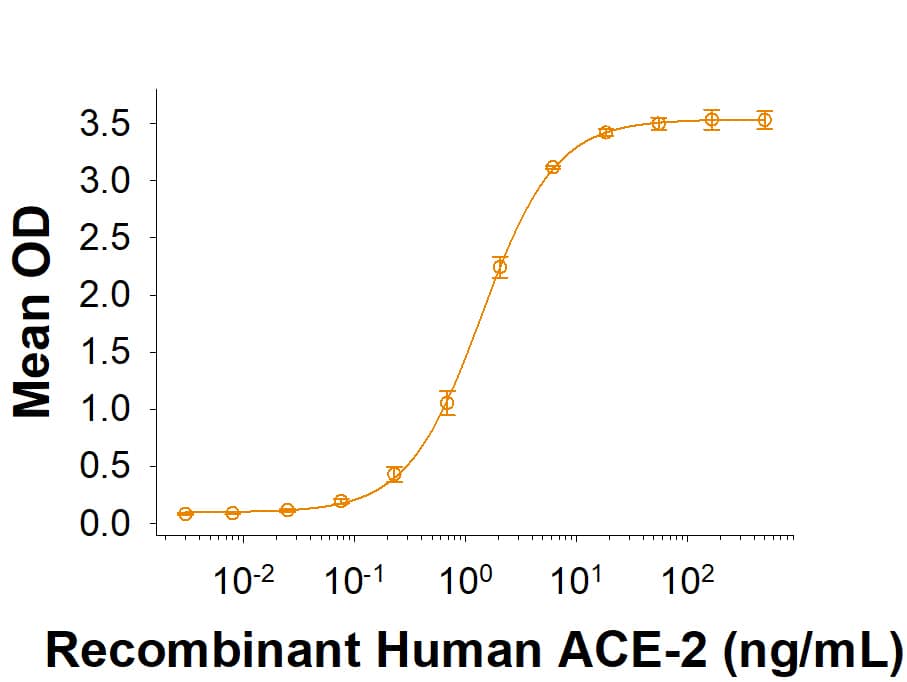Recombinant SARS-CoV-2 Full-length Spike Protein, CF
R&D Systems, part of Bio-Techne | Catalog # 11058-CV
(1-1273 4x aa mut.)

Key Product Details
Product Specifications
Source
Human embryonic kidney cell, HEK293-derived sars-cov-2 Spike protein
Val16-Thr1273 (Arg682Ser, Arg685Ser, Lys986Pro, Val987Pro)
Val16-Thr1273 (Arg682Ser, Arg685Ser, Lys986Pro, Val987Pro)
Purity
>90%, by SDS-PAGE visualized with Silver Staining and quantitative densitometry by Coomassie® Blue Staining.
Endotoxin Level
<0.10 EU per 1 μg of the protein by the LAL method.
N-terminal Sequence Analysis
Protein identity confirmed by mass spectrometry.
Predicted Molecular Mass
139 kDa
SDS-PAGE
140-180 kDa, under reducing conditions.
Activity
Measured by its binding ability in a functional ELISA with Recombinant
Human ACE-2 His-tag
(Catalog #
933-ZN).
Scientific Data Images for Recombinant SARS-CoV-2 Full-length Spike Protein, CF
Recombinant SARS-CoV-2 Spike Protein Binding Activity.
Recombinant SARS-CoV-2 Spike (Catalog # 11058-CV) binds Recombinant Human ACE-2 His-tag ( 933-ZN) in a functional ELISA.Formulation, Preparation and Storage
11058-CV
| Formulation | Supplied as a 0.2 μm filtered solution in PBS and n-Dodecyl-beta-Maltoside. |
| Shipping | The product is shipped with dry ice or equivalent. Upon receipt, store it immediately at the temperature recommended below. |
| Stability & Storage | Use a manual defrost freezer and avoid repeated freeze-thaw cycles.
|
Background: Spike
References
- Wu, F. et al. (2020) Nature 579:265.
- Tortorici, M.A. and D. Veesler (2019). Adv. Virus Res. 105:93.
- Bosch, B.J. et al. (2003). J. Virol. 77:8801.
- Belouzard, S. et al. (2009) Proc. Natl. Acad. Sci. 106:5871.
- Millet, J.K. and G.R. Whittaker (2015) Virus Res. 202:120.
- Ortega, J.T. et al. (2020) EXCLI J. 19:410.
- Wang, K. et al. (2020) bioRxiv https://www.biorxiv.org/content/10.1101/2020.03.14.988345v1.
- Isabel, et al. (2020) Sci Rep 10, 14031. https://doi.org/10.1038/s41598-020-70827-z.
- Tai, W. et al. (2020) Cell. Mol. Immunol. https://doi.org/10.1016/j.it.2020.03.007.1.
- Okba, N.M.A. et al. (2020). Emerg. Infect. Dis. https://doi.org/10.3201/eid2607.200841.
- Cattin-Ortolá, J. et al. (2021) Nat Commun 12:5333.
Long Name
Spike Protein
Alternate Names
S Protein
Entrez Gene IDs
Gene Symbol
S
UniProt
Additional Spike Products
Product Documents for Recombinant SARS-CoV-2 Full-length Spike Protein, CF
Product Specific Notices for Recombinant SARS-CoV-2 Full-length Spike Protein, CF
For research use only
